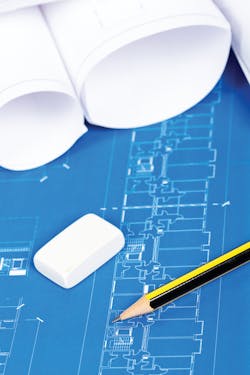Building or renovating an aircraft hangar is a decision that is entered into with much prior planning and large capital investment. Besides the cost of the building itself, these hangars protect contents that are valued in the millions of dollars. A fire incident that would cause these buildings or their contents to be devalued would be catastrophic.
It is for this reason that a large portion of a hangar’s construction costs are invested in fire protection. An adequate fire protection plan will include both, active and passive, fire protection components (these requirements are outlined in NFPA 409, Standard on Aircraft Hangars). The primary active protection are the building’s fire sprinkler and fire alarm systems, while passive components consist of items such as properly constructed fire walls, and dampers in duct work.
It would be a shame to invest all this money in these complex systems only to find, when they were most needed, that they did not function properly, or work appropriately in conjunction with the building’s other components. To prevent this from occurring the National Fire Protection Association (NFPA)-- dedicated to reducing the burden of fire and other hazards to life safety by providing consensus codes and standards, research, and education-- produced document NFPA 3, Recommended Practice for Commissioning and Integrated Testing of Fire Protection and Life Safety Systems.
This standard was created to give clear guidance to the integrated testing of fire systems, and provide a reliable means of ensuring that all active and passive fire and life safety systems work as they are intended.
What is Commissioning?
Fire and Life Safety Commissioning (Cx) is defined as, “a systematic process that provides documented confirmation that fire and life safety systems function according to the intended design criteria set forth in the project documents and satisfy the owner’s operational needs, including compliance with requirements of any applicable laws, regulations, codes and standards requiring fire and life safety systems.”
Essentially, fire and life safety commissioning is a system put into place to ensure that all systems are installed properly and meet applicable codes, standards, and local regulations. Once installed, fire and life safety commissioning is in place to ensure that all these systems work as they should and in harmony with all other systems.
Who Can Provide Commissioning Services?
Although, NFPA 3 does not require any type of certification for commissioning agents, it does outline knowledge and skills that a commissioning agent should posess. The Fire Commissioning Agent (FCxA) is the person or entity who leads, plans, schedules, documents and coordinates the fire protection and life safety commissioning team, implements the commissioning process, and ensures that integrated systems testing is appropriately conducted.
With this as the primary objective a FCxA should possess the following:
?Thorough knowledge of the recommendations of NFPA 3 and general industry practices.
?Capable of providing an objective and unbiased perspective.
?Advanced understanding of the installation, operation, and maintenance of systems to be installed.
?Able to read and interpret drawings and specifications.
?Capable of analyzing and facilitating resolution of issues related to system failures.
?Clear written and verbal communication, report writing and conflict resolution skills
With these as a minimum, NFPA also suggests that the FCxA not have any financial interest in any of the utilized fire equipment, and that the agent have a minimum of five years experience in these types of facilities and related work. Most often, a suitable commissioning agent will be a fire protection engineer, a professional with experience in the design and operation of hangars, or an individual with professional experience in fire and life safety systems.
How is Commissioning Conducted?
Fire and life safety systems commissioning takes place in four phases: planning, design, construction and occupancy. The below information provides an overview of each of these, however, NFPA 3, Chapter 5 provides in-depth direction for each of the phases.
During the planning phase the owner’s project requirements are laid out and developed, the fire commissioning agent is selected and the commissioning team is put into place, the commissioning plan is created, all planning documents and regulatory codes are reviewed and analyzed, and the commissioning plan is put into action.
The fire protection/life safety commissioning team can vary in size and may include the owner, contractors, manufacturers representatives, insurance representatives, design professionals, facilities personnel, the local authority having jurisdiction (AHJ), and others. Each team member must meet the minimum requirements as listed in NFPA 3, Chapter 4.
The OPR, or owner’s project requirements, is the document which will form the basis of all design, construction, testing and operational needs, and will drive the decision-making process. This document should include such vital information as infrastructure requirements, occupancy use and classification, future expansion requirements, applicable codes and standards, and any other special needs or specific requirements. This can be a dynamic document that should be updated as necessary throughout the four phases of the building life cycle.
The basis of design (BOD) is the focal point of the design phase. This is a driving document that should clearly show the concepts, ideas, decisions, codes, regulations and standards required to meet the owner’s project requirements. It is in the design phase that fire protection/life safety system drawings should be reviewed, commissioning procedures outlined and scheduled, and all documents verified to ensure that they comply with the BOD.
It is in the construction phase that all systems are delivered, installed and tested. During this process the fire protection and life safety commissioning team should closely monitor the construction process as they will be responsible for maintaining the commissioning schedule, ensuring that all materials and their installation are in accordance with the BOD, confirm that all work is being conducted by properly licensed and qualified professionals, performing all testing and inspections, and document all actions and any issues. The final action of the commissioning team in this phase is final acceptance testing and turning over all close-out documents to the facility owner.
The occupancy phase is the final stage of the commissioning process. It is at this point that all “loose ends” should be tied up, all final inspections conducted (and passed), all test and inspection reports completed, and system maintenance and product manuals turned over to the building owner. It is important that the owner and other related personnel are adequately trained on the functions, operation and maintenance procedures of the system. Every effort should be made to ensure that this training is complete and high quality, as education is a key component in continued effectiveness of any fire protection or life safety system.
This article provides just a brief introduction to, and overview of, the commissioning process. We have created a special “4 Phases of Commissioning” checklist, which outlines what must be done throughout each step of the commissioning process. It is our hope that this will be a valuable tool that will be utilized, in conjunction with the forms provided in the annex section of NFPA 3, to make the road to commissioning easy to navigate.
Author Bio: Aaron Johnson has been in the fire protection and life safety industry for nearly 10 years. He began his career as a firefighter then transitioned to fire prevention. He currently serves as fire marshal for a Fortune 100 aircraft manufacturing corporation. He also blogs about fire protection and life safety issues at www.TheCodeCoach.com.
PULLQUOTE:
Fire and life safety commissioning is a system put into place to ensure that all systems are installed properly and meet applicable codes, standards, and local regulations.
4 Phases of Commissioning
Planning Phase:
- Develop the owner’s project requirements (OPR) [NFPA 3:5.2.3]
- Select the Fire Commissioning Agent and team [NFPA 3:5.2.2]
- Identify the commissioning scope
- Develop the commissioning plan [NFPA 3:5.2.4]
- Review the planning documents [NFPA 3:5.2.5, 5.2.6]
- Develop regulatory code analysis [NFPA 3:A.5.2.1.2(6)]
- Initiate the commissioning plan
Design Phase:
- Develop the basis of design (BOD) [NFPA 3:5.3.2; Annex B; Annex C]
- Review and approve the sequence of operation
- Review drawings and calculations affecting fire protection/life safety systems
- Document scope of commissioning activities in construction documents [NFPA 3:A.5.3.1(4)]
- Document commissioning procedures
- Develop a commissioning schedule
- Verify that construction documents comply with BOD requirements
- Identify qualified specialists and their responsibilities [NFPA 3:4]
- Coordinate/document commissioning team meetings and progress reports
- Document issues and changes [NFPA 3:A.5.3.1(10)]
- Update the commissioning plan
- Develop construction checklists [NFPA 3:A5.3.1(12)]
Construction Phase:
- Confirm and update commissioining schedule
- Verify that all submittals, plans, data sheets have been reviewed for compliance with the BOD
- Verify that materials, construction, installation are in compliance with the BOD
- Confirm only properly qualified and licensed professionals are performing work
- Coordinate/document commissioning team meetings and progress reports
- Document issues and changs and update the commission plan
- Complete construction checklists
- Perform required observation procedures [NFPA 3:5.4.2]
- Update documents to accout for any revisions or changes
- Verify/document testing and inspections performed [NFPA 3:5.4.3]
Occupancy Phase:
- Complete/document remaining acceptance test and inspections
- Conduct testing for modifications made during construction phase
- Perform deferred testing for seasonal conditions [NFPA 3:A.5.5.2(3)]
- Submit system manual, operation/maintenance manuals, vendor contact list
- Provide training on use and operation of systems
- Deliver record set drawings/documents
- Deliver test and inspection records
- Deliver digital copy of site-specific software [NFPA 3:A.5.5.2(8)]
- Deliver warranty information for the systems and equipment
- Submit recommended preventative maintenance program for systems
- Deliver list of required inspections, tests, and maintenance for systems
About the Author

Aaron Johnson
Aaron Johnson has been in the fire protection and life safety industry for nearly 10 years. He began his career as a firefighter, then transitioned to fire prevention. He currently serves as fire marshal for a Fortune 100 aircraft manufacturing corporation. He also blogs about fire protection and life safety issues at www.TheCodeCoach.com.
